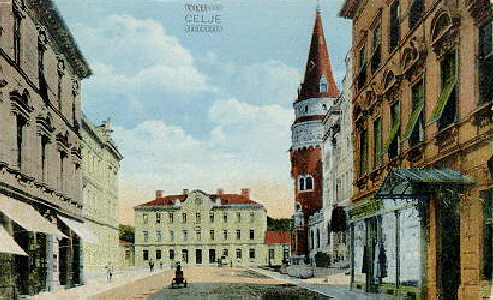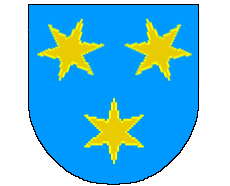Celje
|
|
Celje (German Cilli, Hungarian Cille) (46.24° North, 15.27° East (WG), 241 m, mean height above sea level (MSL) 304 m) is the third largest city in Slovenia. It is a regional center of the Southwestern Lower Styria (Jugozahodna Spodnja Štajerska) and the administrative seat of the municipality of the same name. It is located under the Upper Celje Castle (407 m) at the confluence of the rivers Savinja (also in some older English texts Sann), Ložnica and Voglajna (with its tributary Hudinja) in the lowest part of the Savinja valley.
|
|
|
| Contents |
Symbols
The escutcheon of Celje originates from the Counts of Celje.
The coat of arms of Celje has been integrated into the Slovenian national arms in 1991. The same coat-of-arms was selected for the national arms immediately after the 1st World War in 1918, when Slovenia together with Croatia and Serbia formed the old Kingdom of Yugoslavia.
History
The first urban settlement appeared in the halstatt era.
The city was known in the Celtic times as Kelea when Celts used to coin money here and later on in the Roman Empire as Civitas Celeia. Settlement got its municipal rights in 46 under the name municipium Claudia Celeia during the reign of the Roman caesar Claudius (10 BC-54, reigned 41-54). Antique Celeia had to be a wonderful city. Written records allege it was rich and densely populated, secured with the walls and towers, full of multi-storey marble palaces, wide squares and streets. It was called the second or small Troy - Troia secunda. A Roman road through the Celeia led from Aquileia (Oglej) to Pannonia.
Celeia soon became one of the most flourishing Roman colonies, and possessed numerous great buildings, of which the temple of Mars was famous throughout the whole empire. Celeia was incorporated with Aquileia circa 320 under Roman Emperor Constantine I. (272-337).
During the great migrations of the fifth and sixth century, the city was razed. In the early Middle Ages was again renewed. The first mention of Celje in the Middle Ages was under the name of Cylie in Admont's Chronicle, which was written between the years 1122 and 1137.
Celje acquired market-town status in the first half of the 14th century and town rights on April 11 1451 by orders from the Count of Celje Frederic II (Friderik II).
|
Missing image Celje-1441.JPG image:Celje-1441.JPG Celje southwards on the picture from 1441. The river Voglajna on the left flows into the river Savinja, which streams then to its outfall to the river Sava. On the right of the river Savinja an island can be seen. Even today a ward over there is called the Otok ("An Island"). |
Missing image Celje_Vodni_stolp.jpg Southeastern Vodni stolp ("Water tower") |
In 1473 the city walls and defensive moat were build.
The first train of the route Vienna - Trieste in a so called South railway came to Celje on April 27 1846. In the end of the 19th century and in the early 1900s, Celje was a strong center of German denationalization. At this time, Celje was also known as Celle. A symbol of this remains in the Celjski dom (the Celje hall), which was once called the German house, (German Deutsches Haus), built in 1907. In 1896 the Narodni dom (the National hall) was built, which today hosts the seat of a township. In 1900 Celje had 6,743 citizens. The 1911 Encyclopędia Britannica still names Celje with a German name Cilli.
 An old postcard of the railway station and the Celjski dom on the right. |
Missing image Celje-Celjski_dom.jpg image:Celje-Celjski_dom.jpg The Celjski dom at night. |
Within a few years, citizens of Celje (Slovenian Celjani, singular Celjan, Celjanka, adjective celjski, celjska) split into German and Slovenian sides. Each citizen was forced to define himself. With 1st World War underway, each person needed to take sides. All the way to the fall of the Austrian monarchy in 1918, two mottos were present in the political and social scene: in German "Hie Deusche - hie Slowenen"; in Slovenian "Svoji k svojim" ("Every man to his own"). Because of Celje and Celje citizens and Slovenian parallel classes at Celje gymnasium 1895 even fell Austrian government of Alfred Windischgrätz. That was those days a real precedent.
 Railway station today. |
Missing image Celje_Celjski_dom_001.jpg The Celjski dom. The Celjski dom. |
First telephone in the city was mounted in 1902 and the city was electrified in 1913.
During the 2nd World War Nazis committed a lot of war crimes to the civilians at a war prison called the Stari pisker ("Old pot") and in the surroundings such as Frankolovo, where they had hung many Slovenian patriots on trees. A book of a prisoner's last letters from Stari pisker was published after the war. On April 19 1941 Nazi politician and SS chief leader Heinrich Himmler visited Celje and among other he inspected the Stari pisker. Three days before infamous Gestapo men came to Celje.
Missing image
Celje_Vojna_in_mir.jpg
A monument Vojna in mir ("The war and the peace")
A monument Vojna in mir ("The war and the peace")
The balance of a war was terrible. The city had 20,000 citizens (with nearby towns) and lost 575 people, mostly young ones between 20 and 30 years old. More than 1500 people were ejected to Serbia or into the interior of the German Third reich. Around 300 people were interned and around 1000 people prisoned in Celje prisons. An unknown number of the citizens of Celje were forcibly mobilized in the German army. Many were children. Around 600 "stolen children" were taken to Germany for Germanization. A monument in Celje entitled "Vojna in mir" ("The war and the peace") exists to commemorate these times.
When the war was over, the new government took advantage of the existing anti-tank trenches, dug around Celje by the retreating Germans, using them as graves. They were filled with the Croatian, Serbian and Slovenian armies as well as the civilians, who opposed the communist revolution during the war; this meant physically eliminating the potential political opposition. On the pretext of collaboration with the enemy, the Yugoslavian Army slaughtered more than 30.000 - mostly Croat - prisoners in the Celje area, without any judicial process. The bodies were buried in hidden mass graves in Celje; the exact numbers are still not known. At the concentration camp at Teharje, some 5.000 Slovenians, hundreds of them still minors, were murdered within the two months after the end of the war, again without trial. After the concentration camp was abolished in 1950, the local authorities established a huge industrial dump on the gravesite, thus eventually hiding the bodies under a vast hill of toxic waste. After the fall of the totalitarian regime in 1990, when the facts about the massacre were no longer taboo, the Slovenian government decided to build a memorial to the victims at Teharje.
Subdivisions
Settlements
The urban municipality is divided into 39 settlements (naselja):
Districts and local communities
The settlement Celje has 10 districts (mestne četrti) and the municipality 9 local communities (krajevne skupnosti):
|
Districts
|
Demographics
Today (2002) Celje itself has 47,660 citizens:
- men: 22,744,
- women: 24,816,
- housekeepings: 18,410;
- mean number of housekeeping members: 2,6;
- apartments: 19,578;
- buildings with apartments: 8,090.
The Celje municipal festival is on April 11.
Education
Celje does not have its own university, although some college educational system is present quite a long time.
Law and Government
Mayor or City Executive
The current Mayor of Celje is Bojan Šrot.
Communications
Postal number: SI-3000 (from 1991). (Old one: 63000 (between 1945-1991)).
Miscellaneous
Funny things about Celje
- In colloquial Slovenian Celje is locally called Cjele or Cele, giving it a special modulation, spoken mainly by its citizens.
- Since Celje is the partner city of the German city Grevenbroich it may sometimes happen that strange questions will occur all around, such as this one from one guestbook:
- Celje ist Partnerstadt von Grevenbroich, warum ist alles in englisch geschrieben ???
Famous Celje citizens or people born in Celje
- Emerik Bernard (1937 - ) - painter,
- Jolanda Čeplak (1976 - ) - athlete,
- Anica Černej (1900 - 1944) - poetess, author and schoolmistress,
- Janez Drnovšek (1950 - ) - politician, statesman and 3rd president of Slovenia,
- Thea Gammelin (1906 - 1988) - paintress, (born in Braunshaupten),
- Cvetko Golar (1879 - 1965) - poet and author,
- Andrej Hieng (1925 - ) - author,
- Romana Jordan Cizelj (1966 - ) - physicist and politician,
- Jelko Kacin (1955 - ) - politician,
- Alma Maximiliana Karlin (1889 - 1950) - traveller, author and collector,
- Janez Lapajne (1967 - ) - film director,
- Vladimir Levstik (1886 - 1957) - author and translator,
- Vita Mavrič - chanteuse and singer,
- Vatroslav Oblak (1864 - 1896) - Slavist,
- Janko Orožen - historian,
- Oto Pestner (1956 - ) - musician and singer,
- Andreja Rihter museum working woman and ministress of culture of Slovenia,
- Lojze Rozman (1930 - 1997) - actor,
- August Friderik Seebacher (1887 - 1940) - painter and graphic artist,
- Josip Tominšek (1872 - 1954) - Slavist and mountaineer.
See List of Slovenians.
References
External links
- Celje official web site (http://www.celje.si/)
- Some more general information on the Lord's or Prince's town (http://www.rcc-irc.si/celje/)
- The Celje municipial flag by Željko Heimer (1999-09-24) (http://www.crwflags.com/fotw/flags/si-011.html)
- Template:Coor
- Teharje monument photos (http://foto.rkc.si/main.php?order=files&mode=album&album=Cerkveni_dogodki%2FOdprtje+in+blagoslov+Spominskega+parka+Teharje/)
Template:Slovenia-municipalitiescs:Celje de:Celje nl:Celje ro:Celje ru:Целе sl:Celje sr:Цеље


